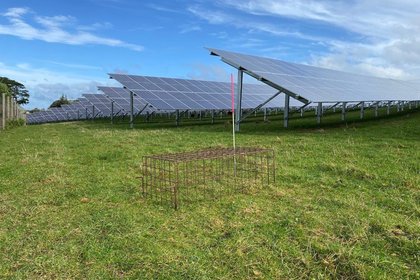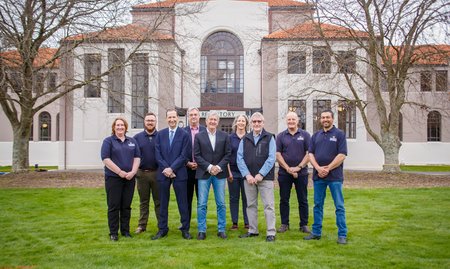
Solar panels on the farm in Taranaki where the trial is taking place.
The researchers’ preliminary results from the first seven months of study indicate that these effects are dependent on where the panels are located. Pasture growth was reduced by 84 per cent directly under the panels, but increased by 38 per cent in the larger areas between panels. Pasture growth in both cases was compared to pasture growth in areas away from the panels.
Professor Danny Donaghy from the School of Agriculture and Environment, who co-led the study, says that direct shading under the panels likely has a negative influence on pasture growth, unlike some previous international research in generally hotter and drier climates.
In contrast, in the area between the solar panels, the panels might offer some ‘protective’ effects, possibly by keeping soil temperatures cooler and also slowing down loss of soil moisture due to wind, compared to an open paddock.
“These results could be used to inform the design of future mixed solar and pastoral farms in New Zealand, including ideal height from the ground and spacing between the rows of installed panels. This would be a win-win for solar farming coexisting with pastoral systems, or even horticultural crops,” Professor Donaghy says.
The research was funded by the Agricultural and Marketing Research and Development Trust (AGMARDT). Pasture performance was measured from July 2022 to January 2023.
Head of the School of Agriculture and Environment Professor Paul Kenyon, who is the other co-lead of the study, is pleased that there is New Zealand-based research to support our farmers.
“We are really just starting to understand the potential impact of solar panels on pastures in our milder and wetter New Zealand climate. The next steps are to collect more data, from across New Zealand, in differing environments.
“It is important to get accurate data for New Zealand conditions. Data is needed over the entire year, or ideally over multiple years and sites, before firm conclusions can be drawn. This pilot project will continue until spring 2023, with additional details collected on pasture growth and quality and the prevalence of facial eczema spores on pasture. We will also conduct an economic analysis of the system with our partners at Lincoln,” Professor Kenyon says.
This year sees the 50th anniversary of Te Kunenga ki Pūrehuroa Massey University holding a site at Fieldays®. In the last five decades, Massey has remained steadfast in its commitment to sharing leading research, innovation and teaching to support the advancement of Aotearoa New Zealand and educate the next generation of global leaders.
Professor Kenyon will be part of the team at the Mystery Creek Pavilion (site PB44) from 14-17 June.
Related news
Massey exploring the potential for combined solar and pastoral farming
A new Massey University study will explore the potential for combined solar and pastoral farming in New Zealand by grazing sheep around solar panels on a Taranaki farm.

Agriculture Minister visits Manawatū campus to launch Whenua Haumanu
The most comprehensive study of pastoral farming ever undertaken in New Zealand was launched today by Agriculture Minister Hon Damien O’Connor.
